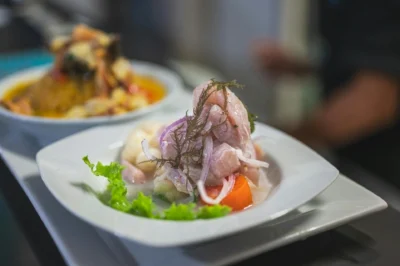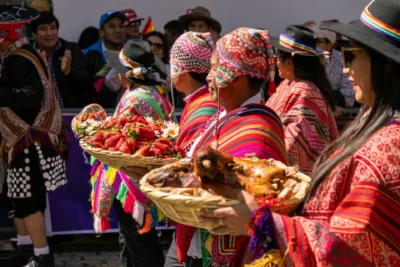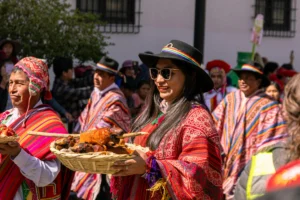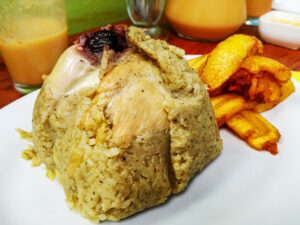Peru is recognized worldwide for its outstanding culinary richness. This Andean country, with its geographical and cultural diversity, has given rise to a unique cuisine that blends authentic flavors and traditional techniques with international influences. If you’re planning to visit Peru, the local cuisine will surely be one of the experiences you’re most excited to explore.
From the fresh flavors of the coast to the intense nuances of the highlands and the jungle, each corner of the country offers something unique to enjoy. With Machu Picchu Wayna, you’ll have a complete journey through the most representative dishes, drinks, and sweets, and you’ll discover why this cuisine has become a tourist attraction in its own right.
Typical Food of Peru
Peruvian cuisine is divided into three main regions: the coast, the highlands, and the jungle. Each of these regions offers ingredients and preparations that reflect the country’s natural and cultural diversity.
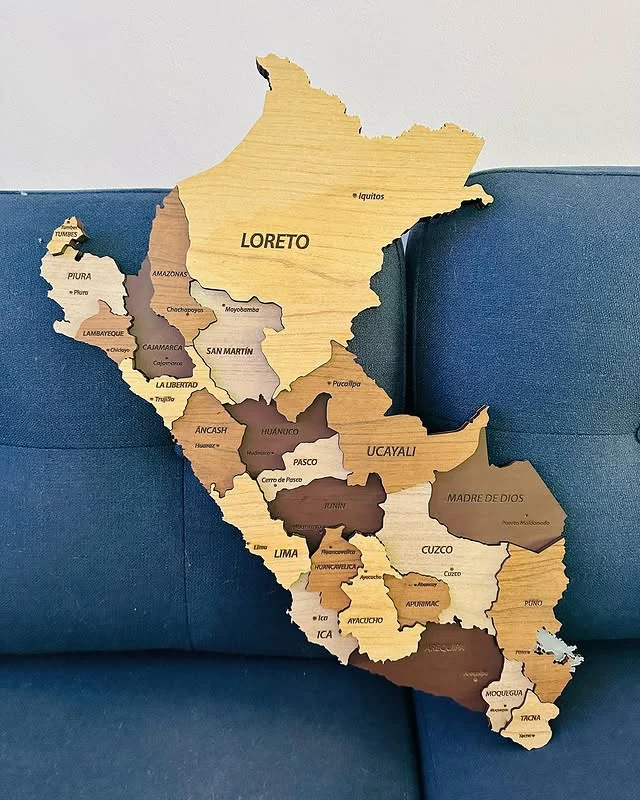
Coastal Cuisine
The cuisine of the Peruvian coast reflects the maritime richness and cultural heritage of the regions near the Pacific Ocean. This gastronomy is characterized by the predominant use of fresh fish, seafood, and products such as chili, lime, and cassava, which highlight the freshness and flavor of its dishes.
Traditional dishes from the coast of Peru are classified into seafood cuisine and Creole cuisine. Each region modifies its dishes based on its products and traditions.
Representative Dishes of the Peruvian Coast
Peru has an extensive coastline along the Pacific Ocean, which allows it to offer a variety of high-quality marine products. This region is home to fresh dishes, such as ceviche, prepared with local ingredients and techniques that enhance their natural flavor.
Ceviche: The Star Dish of the Coast
Considered the flagship dish of Peruvian cuisine, ceviche is a preparation made with fresh fish marinated in lime juice, with added onion, chili, cilantro, salt, and pepper, giving it a unique flavor. It is a culinary experience you must try if you visit Peru.
Although there are various interpretations of its origin, it is believed to have originated in pre-Columbian times, and with the arrival of the Spanish, lime and onion were added.
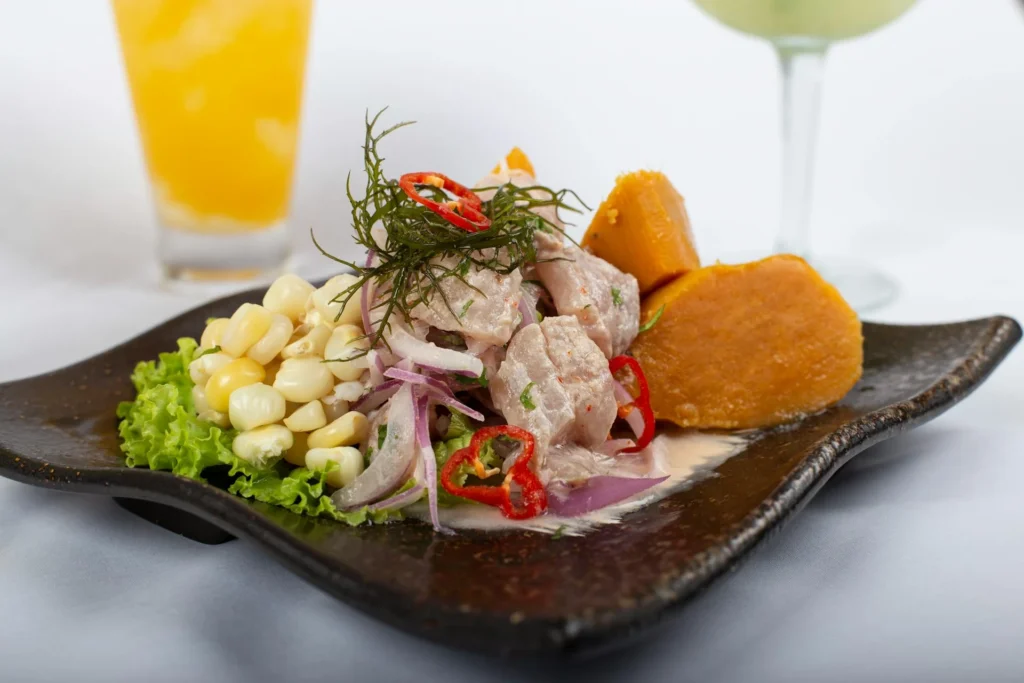
Rice with Seafood
Rice with seafood (Arroz con Mariscos) is another very popular dish on the Peruvian coast. This dish combines seasoned rice with a mixture of fresh seafood, such as shrimp, squid, and shellfish, along with spices, ají panca, and cilantro, resulting in an intense and balanced flavor. It stands out for its vibrant color and rich flavor, a result of the fresh ingredients and the richness of the Peruvian land.
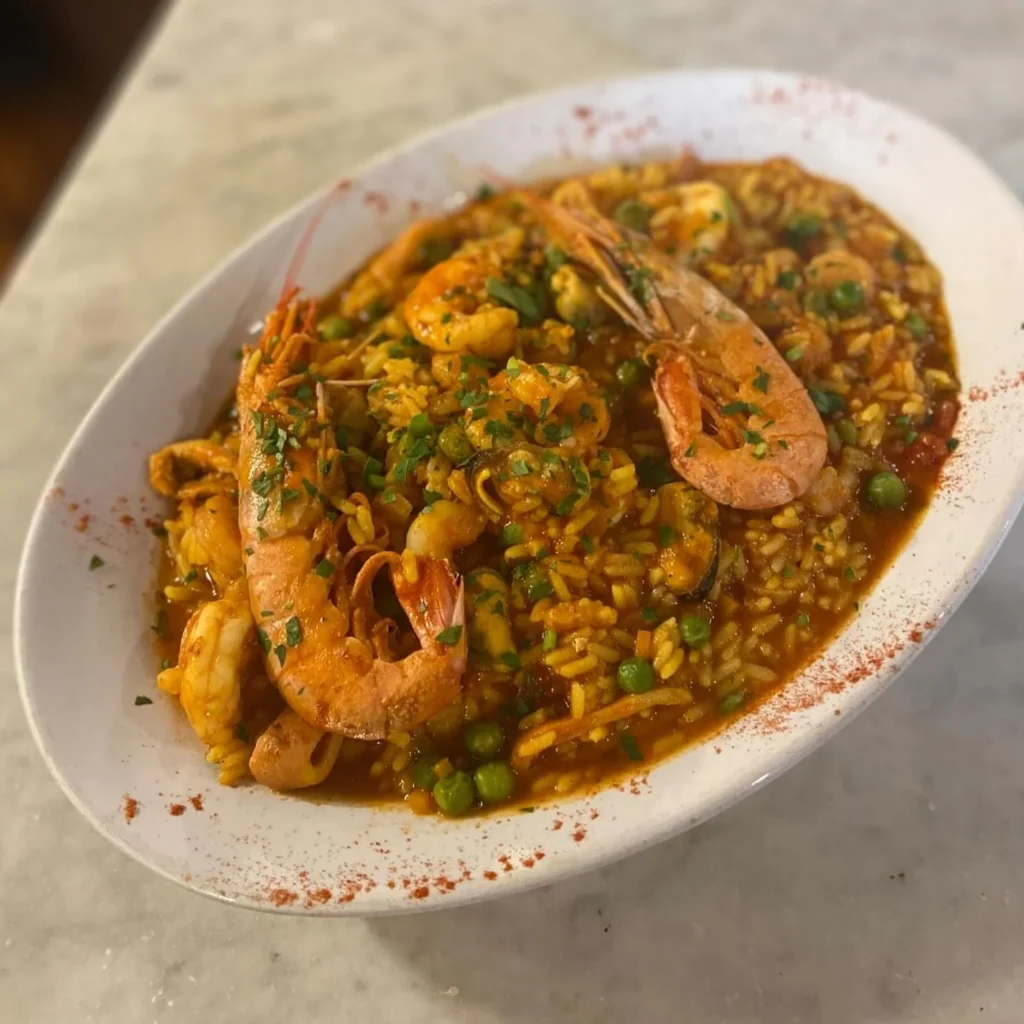
Causa Limeña
Made with pressed yellow potatoes and seasoned with lime and yellow chili, it is filled with chicken, tuna, or seafood, creating a fresh and colorful appetizer.
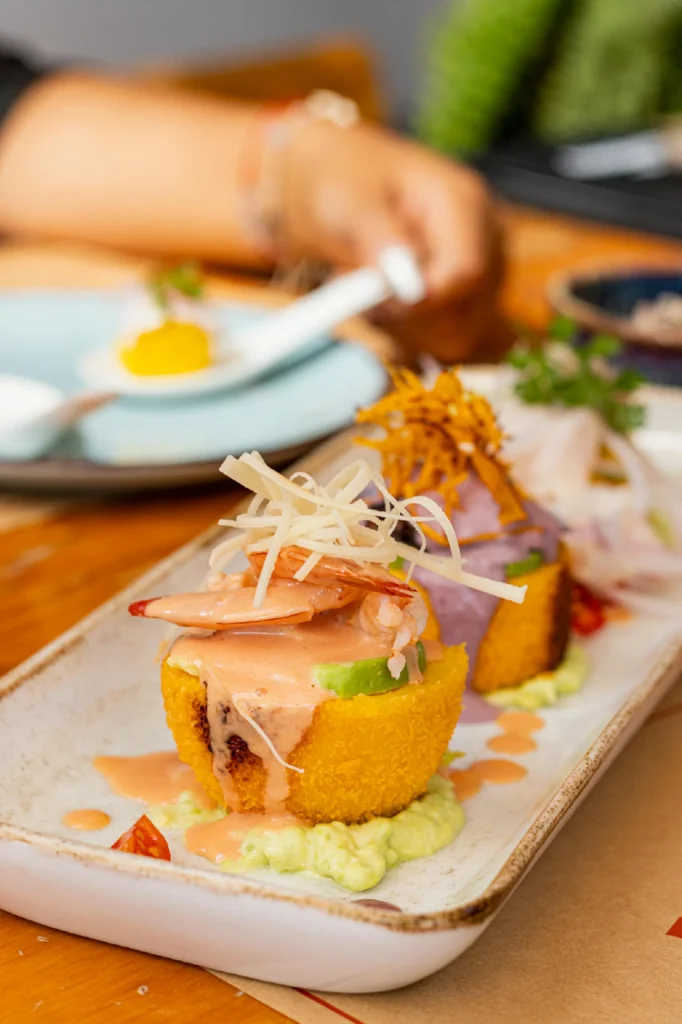
Shrimp Soup (Chupe de Camarones)
Although more popular in the southern coast, this thick stew combines shrimp, milk, potatoes, corn, rice, and spices, making it a comforting and hearty dish.
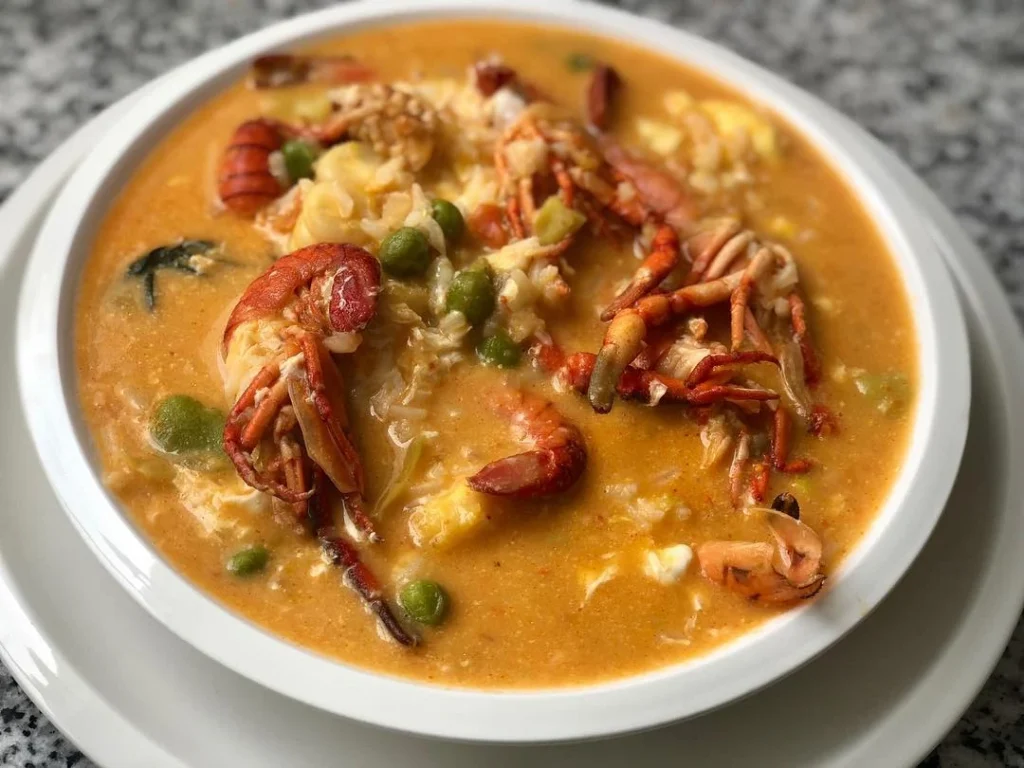
Highland Cuisine
The Peruvian highlands are characterized by a cuisine that makes use of native Andean products, such as potatoes, corn, and quinoa, combining ancient techniques and deep flavors.
Traditional Dishes of the Peruvian Highlands
The cuisine of the Peruvian highlands is an expression of its cultural and geographical diversity, with dishes that highlight indigenous ingredients such as potatoes, corn, aromatic herbs, and meats. Some of the most representative traditional dishes include:
Chiri Uchu
Chiri Uchu is the main specialty of the city of Cusco. It comes from the Quechua words “Chiri,” meaning “cold,” and “uchu,” meaning “chili.” This exquisite dish is consumed cold and consists of seaweed (cochayuyo), eggs, guinea pig, chicken, hen, dried meat (charqui), blood sausage (morcella), potatoes, corn tower, cheese, and rocoto pepper.
Many people consider Chiri Uchu to be the food of the Incas. The secret lies in consuming a bit of each ingredient to fully enjoy this exquisite preparation.
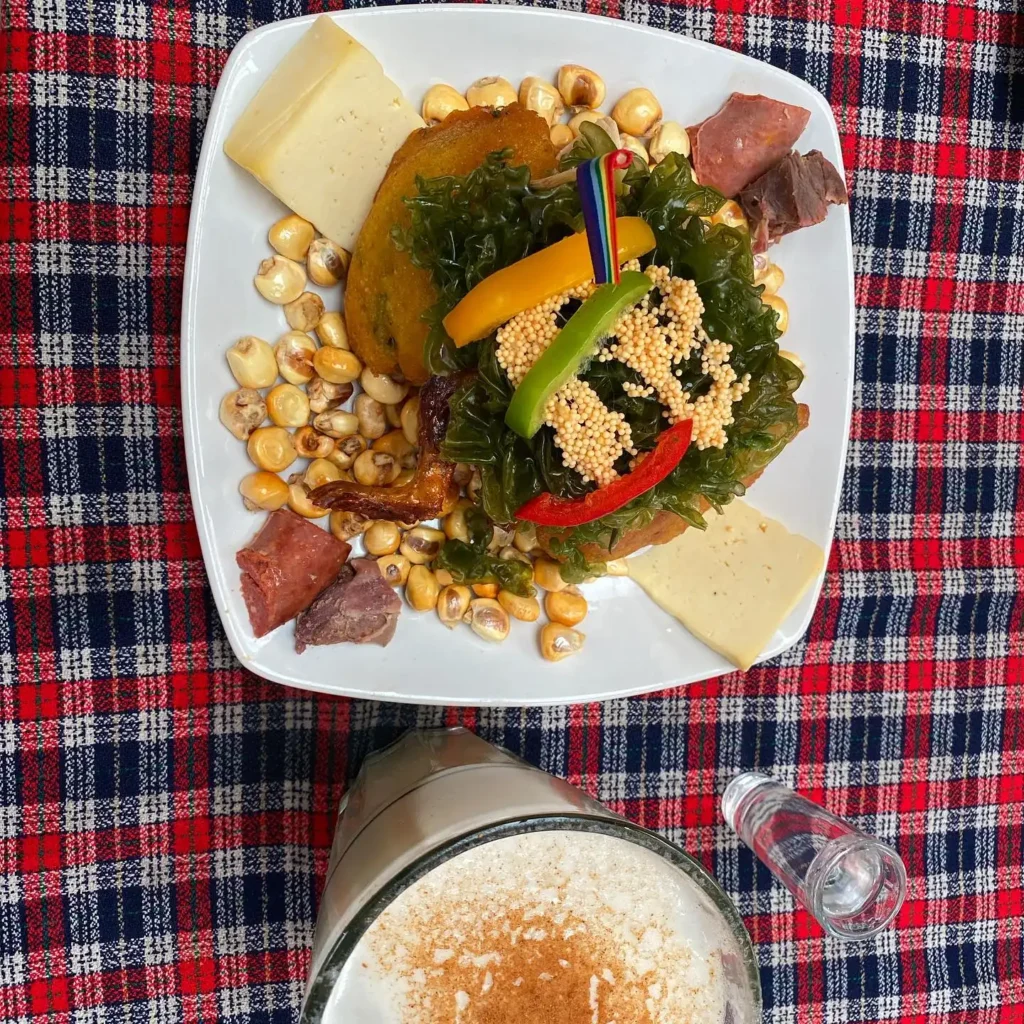
Pachamanca
It is a ceremonial dish that symbolizes the connection with the land. It is prepared by cooking meats (chicken, pork, lamb, and guinea pig), potatoes, fava beans, and corn in an underground oven with hot stones, seasoned with herbs like chincho and huacatay.
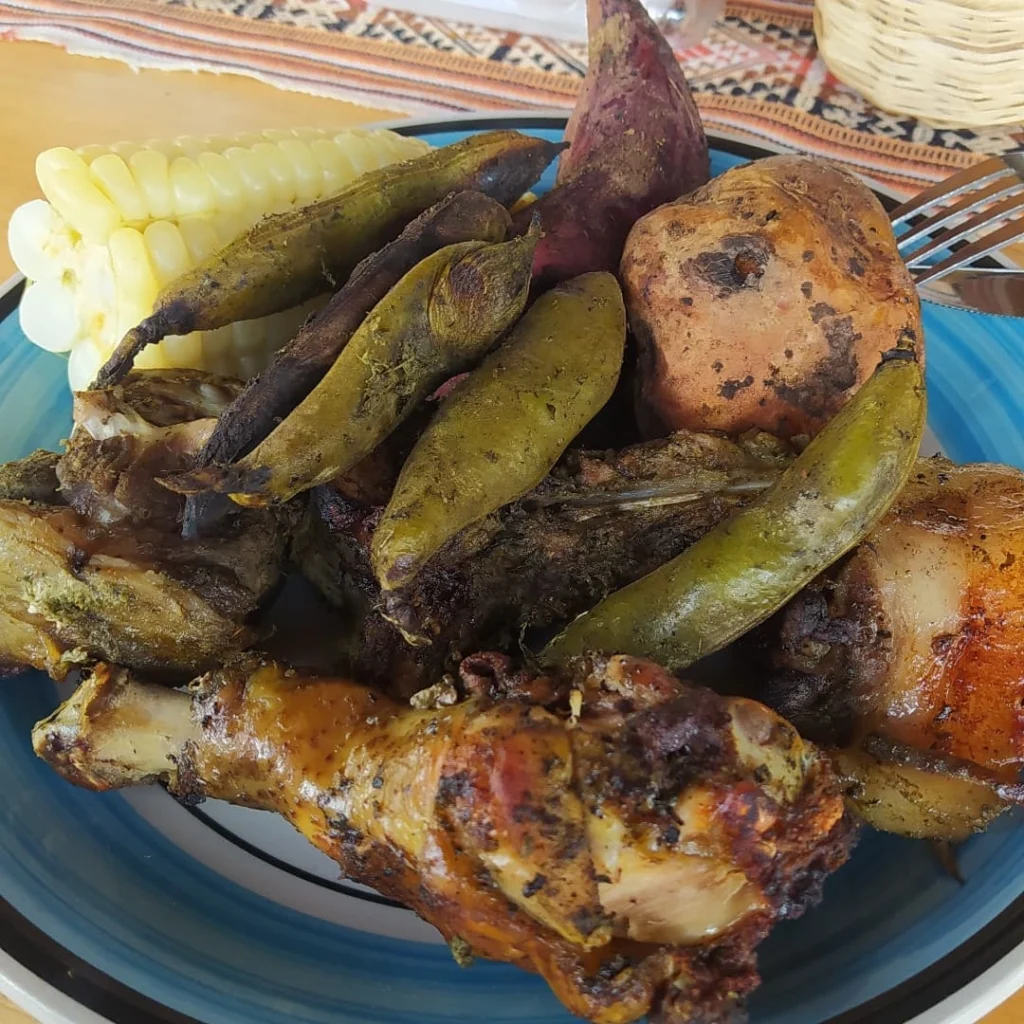
Pork Crackling (Chicharrón de Chancho)
This traditional dish from Cusco consists of pieces of pork slow-cooked in its own fat until crispy on the outside and juicy on the inside. It is served with mountain bread, corn (choclo), and Creole sauce, making it a classic for Sunday breakfast and local festivities.
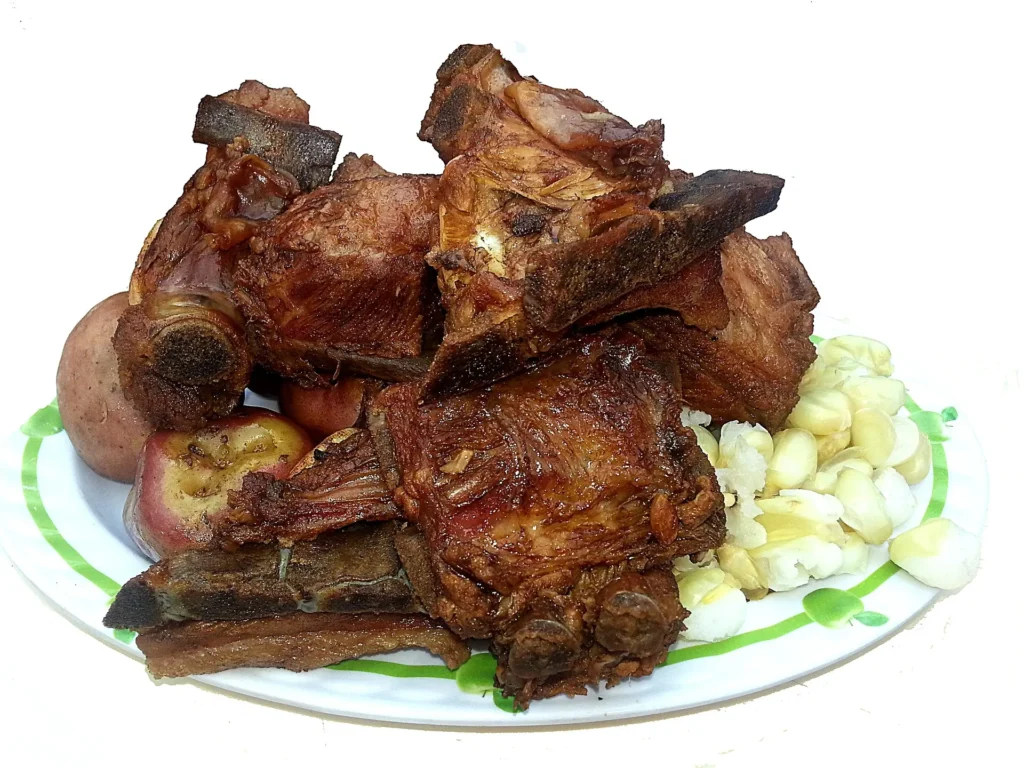
Fried and Roasted Guinea Pig (Cuy Chactado y al Horno)
The Andean guinea pig (cuy) is a well-known and widely consumed animal in the highlands, considered both a culinary and cultural tradition. Cuy chactado is prepared by frying the whole guinea pig in plenty of oil, achieving a crispy skin and tender meat. It is usually served with potatoes, salad, and spicy sauces like ají.
On the other hand, cuy al horno stands out for its flavor, which relies on good seasoning with herbs and spices before being slowly roasted. It is typically served whole, accompanied by corn, potatoes, and ocas, with both dishes being symbols of Andean cuisine and festive celebrations.
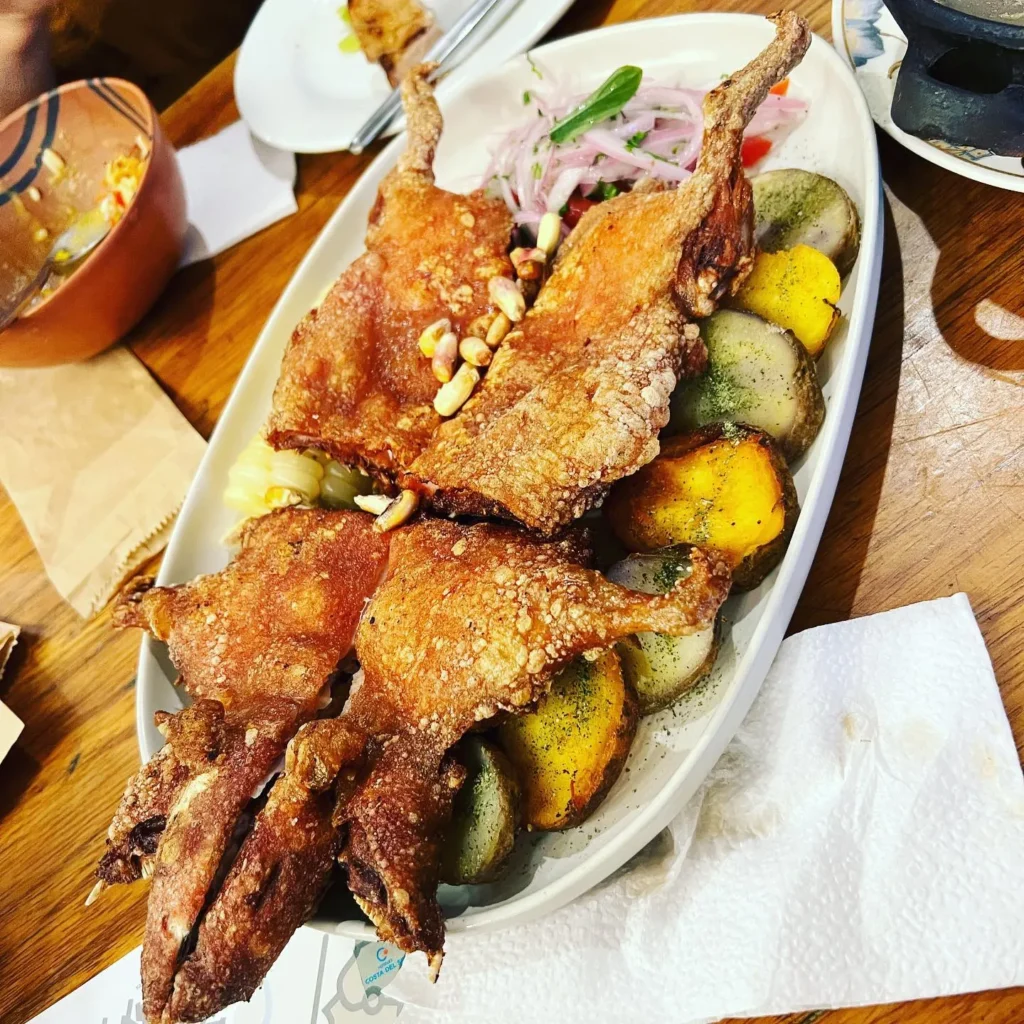
The Andean Influence in Highland Cuisine
The cuisine of the Peruvian highlands is influenced by Andean tradition, based on native ingredients such as potatoes, corn, quinoa, and guinea pig. Ancient techniques such as chuño, pachamanca, and charqui reflect a sustainable connection with nature, while local herbs like huacatay and chincho add unique flavors.
This culinary heritage, tied to rituals and festivities, stands out for its cultural richness and its connection to the Andean worldview.
Jungle Cuisine
The food of the Peruvian jungle reflects its biodiversity and Amazonian culture, using fresh and exotic ingredients.
Some of the most representative dishes include juane (rice with chicken, egg, and olives wrapped in bijao leaves), tacacho with cecina (roasted green plantain with smoked pork), patarashca (grilled fish wrapped in bijao leaves), inchicapi de gallina (thick soup made with peanuts, chicken, cassava, and corn), chonta (heart of palm salad), and fried paiche (large Amazonian fish).
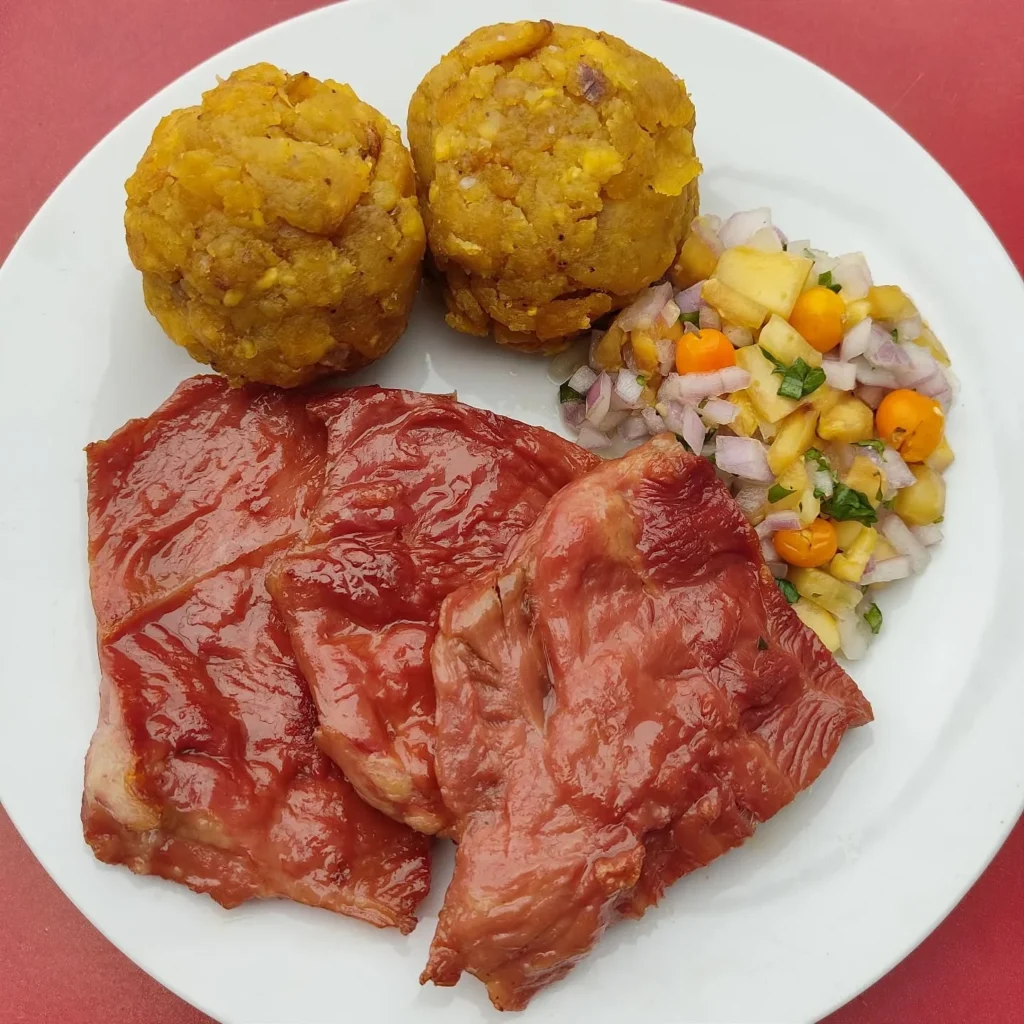
Exotic Flavors of the Peruvian Amazon
The biodiversity of the jungle provides unique ingredients that lead to preparations with intense aromas and varied textures. Some examples of these flavors include:
- Amazonian chili peppers: Such as the charapita chili, small but with an intense flavor, used to make sauces and seasonings.
- Tropical fruits: Ingredients like camu camu, aguaje, and cocona, known for their sweet and sour taste, are used in drinks, desserts, and main dishes.
- Exotic meats: The jungle offers proteins like paiche (giant fish), sajino (wild pig), and venison, which are prepared in stews, roasts, or fried.
- Local herbs and spices: Plants like sacha culantro and bijao leaves add an aromatic and distinctive touch to soups and tamales.
- Chicha de maíz and masato: Traditional fermented drinks that reflect the ancestral practices of Amazonian communities.
Typical Beverages of Peru
Peruvian beverages also hold an important place in its cuisine, with pisco, a national drink, being its foremost representative.
Types of Pisco and Its Varieties
Pisco is a Peruvian grape brandy made from the distillation of fresh juices derived from the unique fermentation of grape must, which provides its own liquor. It originates in Peru, with a variety of types and categories depending on the grape used, the distillation process, and the production region. The main types of pisco and their varieties are:
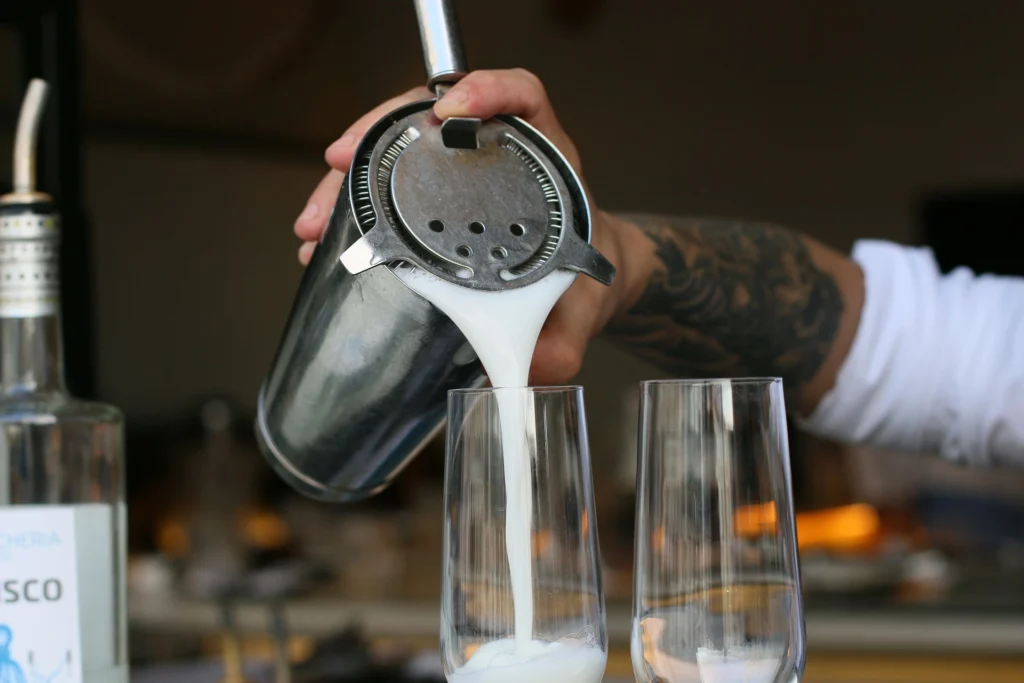
Pisco Puro: Made from a single grape variety, it can come from different types of grapes, such as:
- Pisco Quebranta: The most common and traditional variety, with a smooth and fruity flavor.
- Pisco Negra Criolla: Made from black grapes, offering a more intense flavor with a floral touch.
- Pisco Mollar: Less common, made from Mollar grapes, giving it a sweet and smooth flavor.
Pisco Aromático: Made from aromatic grapes, which have a more intense flavor and aroma. Some of the most well-known varieties are:
- Pisco Torontel: With a floral and fruity aroma, it is very popular for cocktails.
- Pisco Italia: With a more floral and fruity profile, highly appreciated for its smoothness.
Pisco Mosto Verde: Made from must (grape juice) that hasn’t completed its fermentation process. This type of pisco is smoother and sweeter because it is not fully fermented, resulting in a more aromatic and higher-quality product.
Pisco Acholado: A blend of different grape varieties, including both Quebranta and aromatic grapes. This blend gives it a balanced and versatile flavor, ideal for cocktails and traditional drinks like Pisco Sour.
Each type of pisco has unique characteristics that make it special, and its production is mainly regulated in the regions of Ica, Arequipa, Lima, and Moquegua, where the geographical and climatic conditions are ideal for viticulture.
The Pisco Sour and Its History
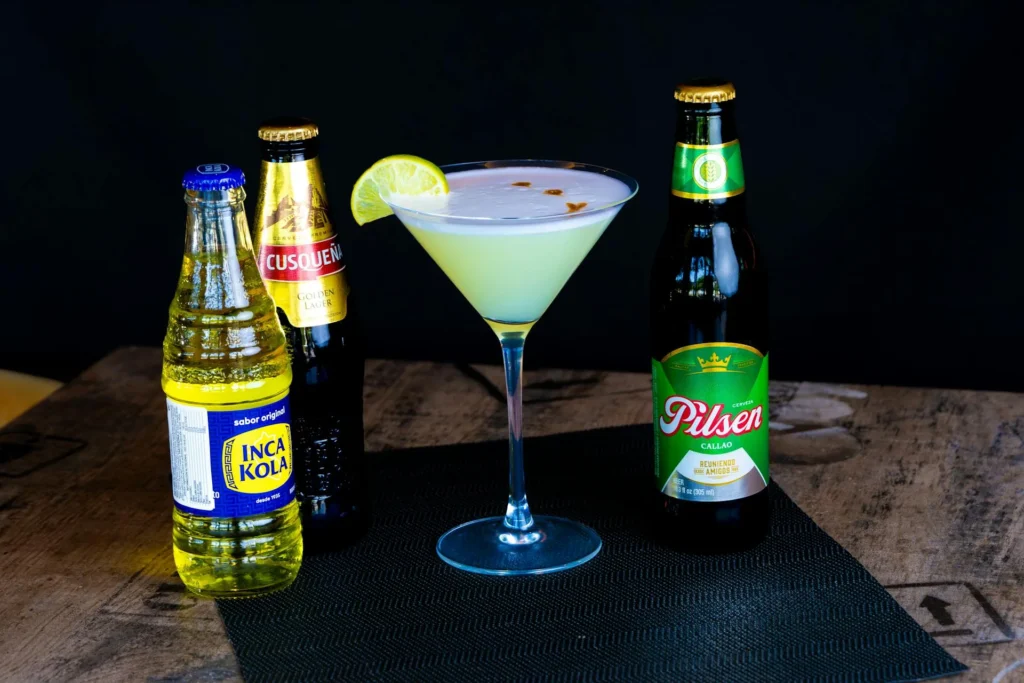
The Pisco Sour is an iconic cocktail of Peru, considered the country’s national drink. Its origin dates back to the 1920s, and while there are several theories about its creation, the most widely accepted one is that it was invented by the American Victor Vaughen Morris. Morris, a bartender who arrived in Lima, Peru, in the early 20th century, opened a bar called Morris’ Bar.
In this establishment, he began experimenting with pisco, a traditional Peruvian grape brandy, and mixed it with other local ingredients such as lime juice, sugar, egg white, and Angostura bitters, thus creating the Pisco Sour.
The recipe quickly gained popularity among the people of Lima and, over time, became one of the most representative drinks of Peru. In 2003, the Congress of Peru declared Pisco Sour the national drink of the country and established that the first Saturday of February should be celebrated as Pisco Sour Day.
Other Iconic Beverages of Peru
In addition to the Pisco Sour, Peru is known for a variety of iconic drinks that reflect the country’s cultural and geographical diversity. Some of the most notable ones are:
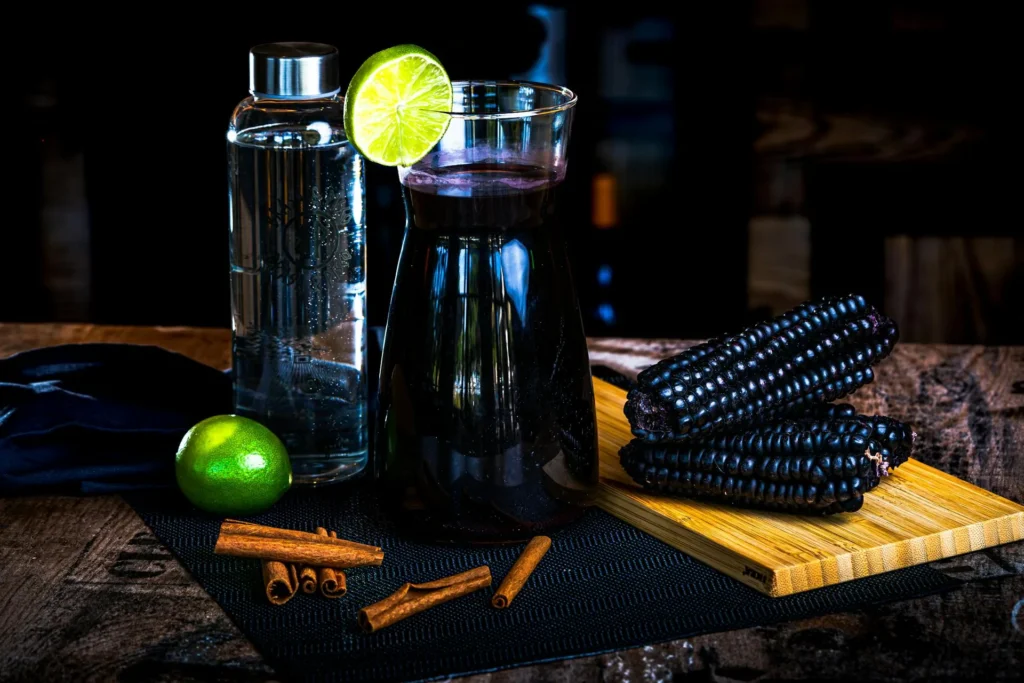
- Chicha Morada: Es una bebida refrescante y no alcohólica hecha a base de maíz morado, que se hierve con piña, canela, clavo y azúcar. Es muy popular en todo el país, especialmente en las festividades, y se destaca por su color vibrante y sus propiedades antioxidantes.
- Inca Kola: Conocida como «la bebida de los peruanos», es un refresco gaseoso de sabor único y dulce, con un color amarillo brillante. Se ha convertido en un símbolo nacional y se consume ampliamente en Perú.
- Chicha de Jora: Esta es una bebida tradicional de la región andina, hecha a base de maíz fermentado. Dependiendo del proceso de fermentación, puede ser alcohólica o no. La chicha de jora es fundamental en las celebraciones y rituales de las comunidades andinas.
- Emoliente: Una bebida caliente y reconfortante, se prepara con cebada, linaza, muña, y otras hierbas medicinales, y se cree que tiene propiedades digestivas y energizantes.
- Mate de Coca: Esta infusión, hecha con hojas de coca, es tradicional en las regiones altas de los Andes. Se consume para aliviar el mal de altura, y es conocida por sus propiedades energizantes y digestivas.
- Té de Hierbas: En las zonas rurales de Perú, especialmente en los Andes, es común consumir tés de hierbas locales como la muña, baldosa o huamanripa, que se preparan por sus propiedades curativas, digestivas y para aliviar malestares comunes.
Typical Sweets of Peruvian Cuisine
Peruvian cuisine is also known for its variety of traditional sweets, which combine indigenous flavors with influences from Spanish colonization. Some of the most representative sweets include:
Picarones
Picarones are a sweet delight similar to doughnuts, made from a dough of flour and squash, and drenched in chancaca syrup (a sweet syrup made from unrefined sugar). This dessert is especially enjoyed during celebrations and fairs.
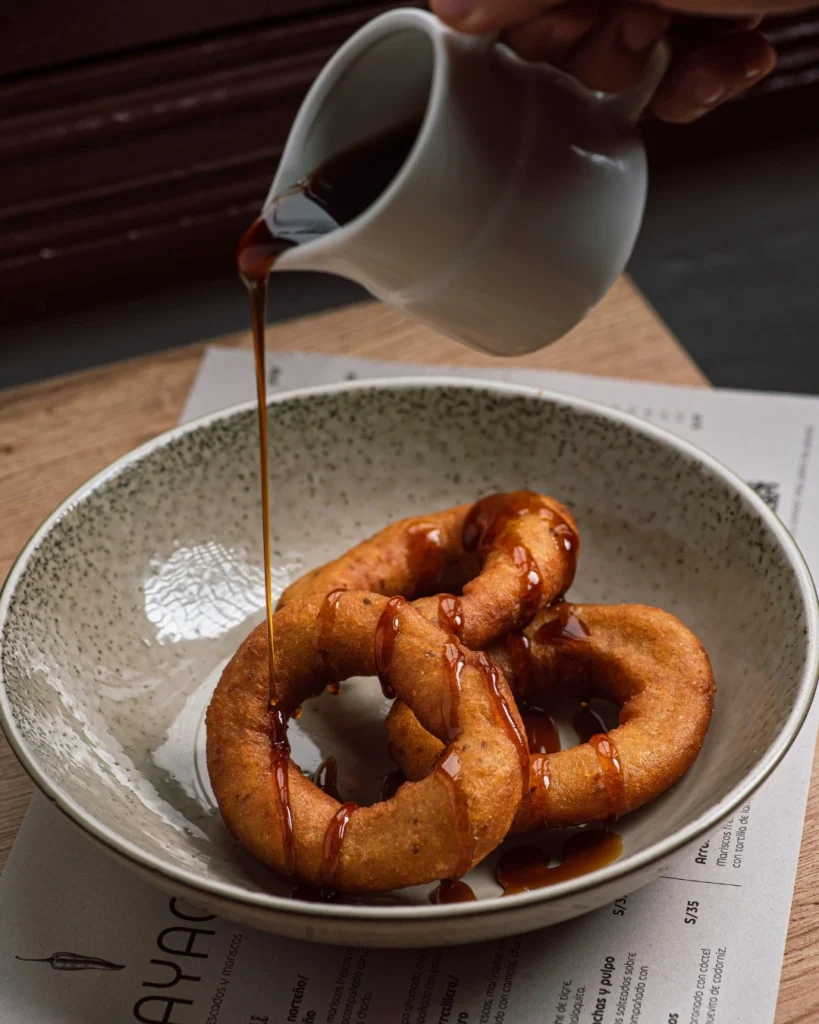
Doña Pepa’s Nougat (Turrón de Doña Pepa)
This traditional sweet is very popular during the month of October, especially during the Señor de los Milagros festival. It consists of a mixture of anise cookies soaked in chancaca syrup (sugarcane syrup) and decorated with colorful candies.
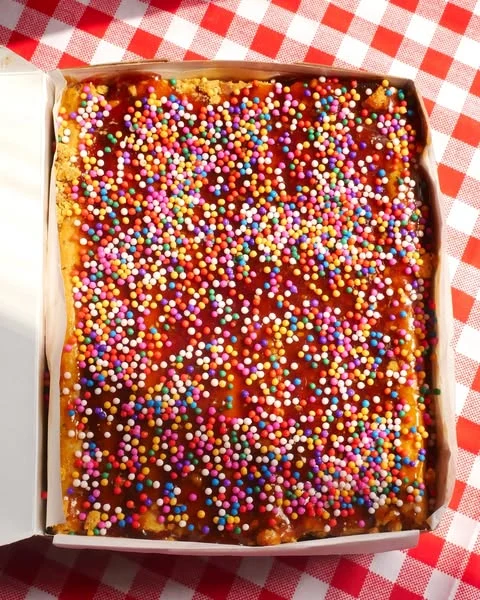
Purple Corn Porridge (Mazamorra Morada) and Its Roots
Made from purple corn, this dessert is one of the most representative delicacies of Peru. It is cooked with pineapple, cinnamon, cloves, and sugar, and has a thick, gelatinous texture. It is commonly served with rice pudding (arroz con leche).
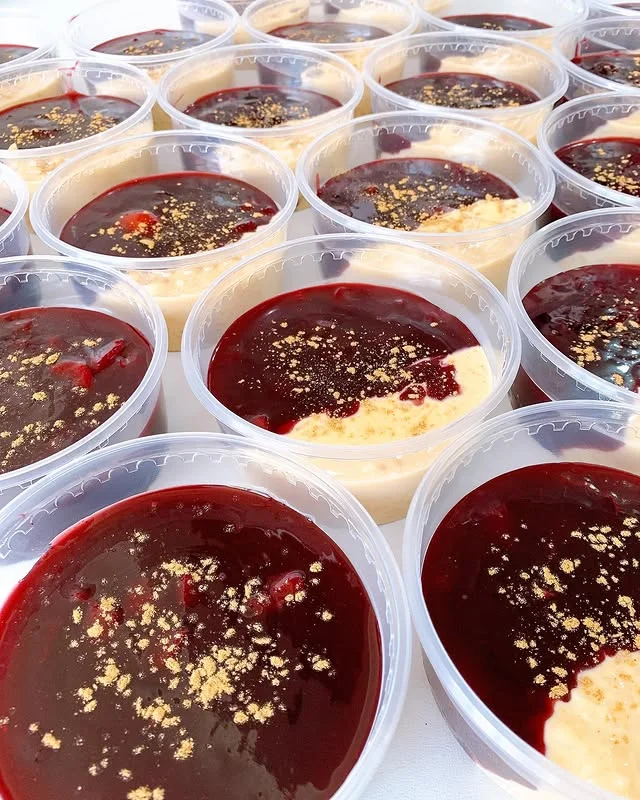
Arroz Zambito
Arroz Zambito is a variation of rice pudding, but it is made with chancaca and grated coconut, giving it a deeper color and flavor. It is a comforting sweet dish full of history.
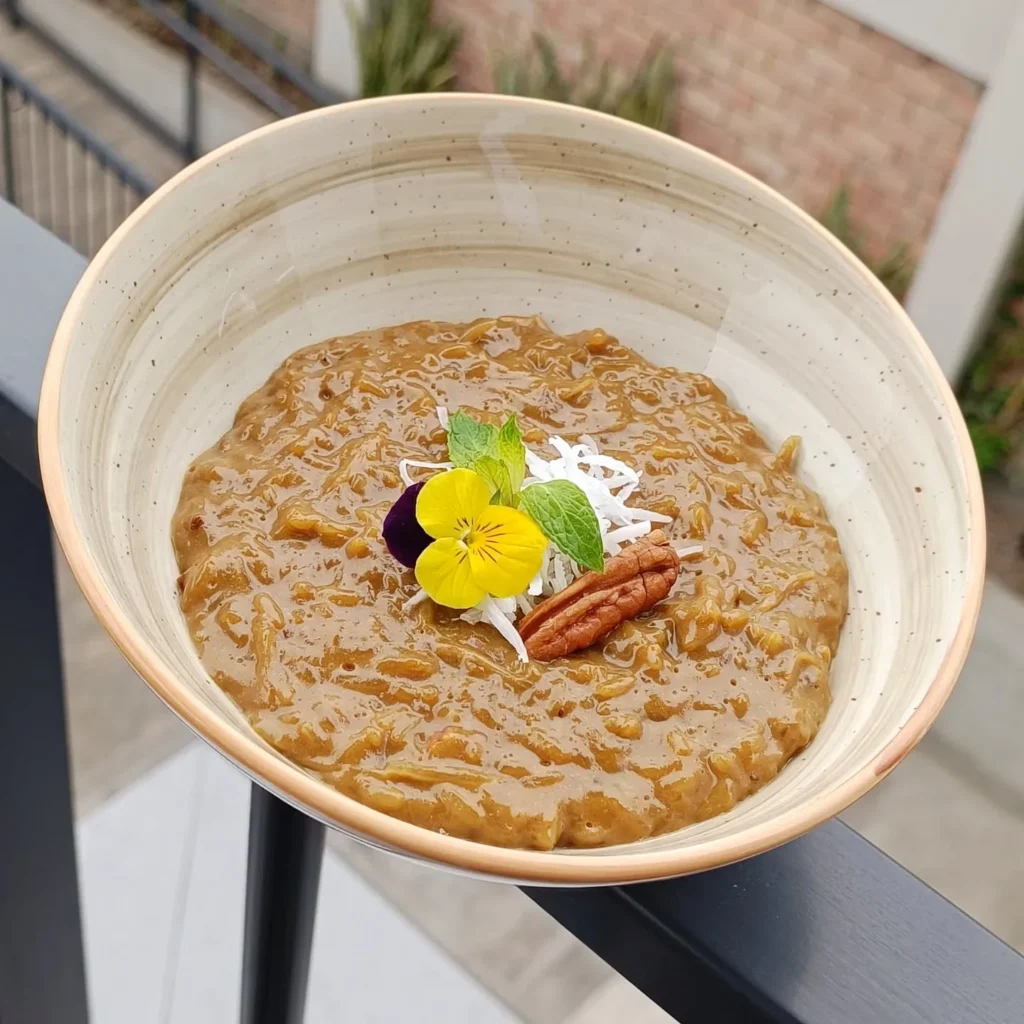
Peruvian Cuisine as a Tourist Attraction
Gastronomic Routes in Peru for Tourists
Perú ofrece diversas rutas gastronómicas para turistas, que destacan su rica diversidad culinaria. Algunas de las principales son:
- Ruta del Ceviche (Costa Peruana): Recorrido por Lima y otras ciudades costeras para degustar ceviches frescos y aprender sobre ingredientes como el ají limo y el pescado fresco.
- Ruta de los Andes (Sierra Peruana): Recorre Cusco, Arequipa y Puno, donde se pueden probar platos como pachamanca, cuy chactado y rocoto relleno.
- Ruta de la Selva (Amazonía Peruana): En ciudades como Iquitos y Puerto Maldonado, los turistas pueden disfrutar de platos como juane, tacacho con cecina y paiche, con ingredientes autóctonos.
- Ruta de los Postres (Gastronomía Dulce Peruana): Un recorrido por Lima, Cusco y Arequipa para degustar dulces tradicionales como mazamorra morada, turrón de Doña Pepa y picarones.
- Ruta del Pisco y la Alta Cocina (Ica y Lima): Visita a bodegas de pisco en Ica y degustaciones en Lima, con el famoso Pisco Sour.
- Ruta de la Quinua y Superalimentos (Andes y Costa): Tour para descubrir la quinua, cañihua y maca, y disfrutar de platos saludables y modernos.
Estas rutas ofrecen una inmersión completa en los sabores y tradiciones de Perú.
Recommended Culinary Experiences for Travelers
Peru offers various culinary experiences for travelers, such as cooking classes to learn traditional dishes, gastronomic tours through local markets, pisco tastings at wineries in Ica, and enjoying ceviche at coastal cevicherías.

You can also experience pachamanca in the Andes, try Amazonian dishes like juane in the jungle, and enjoy haute Peruvian cuisine at renowned restaurants like Central and Maido.
Travelers can enjoy experiences such as cooking classes, visits to local markets, and tasting tours at famous restaurants, where Peruvian chefs showcase their creativity.
Why Is Peruvian Cuisine Unique?
Peruvian cuisine is unique for its diversity of native ingredients, such as potatoes, quinoa, corn, and guinea pig, which are fundamental to its culinary tradition. Additionally, it stands out for the fusion of cultures, as over time, the traditions of pre-Columbian civilizations like the Incas, the influences of Spanish colonizers, and the contributions of Asian immigrants (mainly Chinese and Japanese) have shaped iconic dishes like ceviche, lomo saltado, and tiradito.
This cultural richness is complemented by the use of traditional techniques like pachamanca (cooking food underground) and the preparation of dishes like juane. Furthermore, Peruvian cuisine has gained international recognition, with Peruvian chefs excelling in the world of haute cuisine, which has further elevated its visibility and prestige globally.
